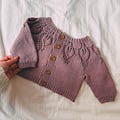Thank you so much for reading The Slow Natured Journal! This is a reader supported publication and I am so grateful to all those who have upgraded to a paid subscription. If you haven’t already, please consider upgrading to not only help me continue making content to help you live your best handmade, homegrown and slow life but also to unlock all the great content already created this year. I’d love you to join us!
I was ten years old when I first learned to knit. I had spent a weekend at a family friends home whilst my parents were away. My Mum’s best friend, Anju, was originally from New Delhi and so it had been a fantastic weekend of delicious north Indian food and much fun (as was usual at her house!). Anju’s parents were over from India for a few weeks and her Mum had brought her knitting with her. Sat in swathes of beautiful earth toned sari fabric, Kamla would spend much of her time clicking away at some project or other. This weekend it was a simple scarf for her Granddaughter. I became absolutely mesmerised by the rhythmic click clack of the needles. How the same movements again and again with the yarn formed a fabric that could be shaped into something wearable.
I had always been interested in crafts, no good at drawing or painting, I had believed as a child that I wasn’t “artistic” and eschewed art at school. At home however, my creative flare came out in the form of cross stitch, card making and later on yarn crafts and dressmaking. Looking back now I see how I was trying to make sense of the world through textiles. To express a level of creativity that has been with me all my life and that I can’t help but release in some way.
20 years ago on that summer weekend in 2004, I didn’t just want to learn to knit I needed to. The pull to put yarn and needles together and create fabric was so great. And luckily, Kamla was very happy to show me the basics of the knit and purl stitch. She didn’t have any spare yarn or needles with her so it was a lesson through watching. In through the needle, wrap the yarn around, pull the needle back through and drop the stitch off the end. A never ending cycle of knit stitch until the lacy mohair style scarf was finished and ready to be cast off.
My Auntie came to pick me up from that weekend and stayed with me and my siblings for the rest of the week. I wouldn’t stop chattering about knitting and yarn and so we went off to the shop and bought what we needed. She then picked up the mantle and taught me the basics of casting on, knitting and purling and then casting off.
From that week onwards a series of women would input into my knitting journey. My maths tutor who ran the knitting club at her school, would show me how best to hold my needles. My Granny would find balls of spare yarn in her stash that I could take home and practise with. Later, at 24 years old and in my first real job as a school librarian, I would be inspired by the other library assistant to pick up my needles once more. And a desire to create ethical and sustainable clothing lead me back to knitting just a few months before I would desperately need it.
None of those women could have known what they were doing. They simply passed on a skill that has been passed down from woman to woman for centuries. A skill that has clothed children, brought in an income to help feed a family, created artwork and stilled anxious minds for generations. None of us could have known that knitting would one day save my life. That when I became chronically ill in 2019 and almost completely housebound, it would become an essential part of my identity and later, my recovery. Knitting kept me going. It gave me a whole new career, one that I can manage from home with my illness.
And so I too have passed on the mantle. I share my makes and works and ideas across social media in an attempt to inspire others. I help answer questions on knitting dilemmas, and I run a monthly crafts night at my church where I can encourage and teach more people to take up their needles.
Sadly, Kamla is no longer with us but back in April what would have been her first great Granddaugter was born. I knew I had to knit something for her, this little baby. To weave together the stitches once taught by her great Grandmother into a garment that she could wear and perhaps treasure for years. There is history and love in those stitches. Each twist of the yarn pulled through a stitch tells the story of women who have taken time to teach a skill which brings not just use but joy and hope to a family. My hope for this new little soul in the world is that she feels the love of her ancestors as she wears this new cardigan. That the history and stories of people gone before her can be seen in this tangible piece.
Perhaps, one day she will also learn those stitches and teach them to her children. A family legacy passed down in the click clack of the needles.
Disclaimer: I would just like to say that I love and support male knitters and this article does not seek to exclude them. Knitting is for everyone. This article however, was about my history and my heritage. There have been male knitters throughout history but it has been predominantly a female craft passed down from woman to woman and I think there is something intrinsically beautiful about this and so I hope you enjoy my reflections on the subject.





I love this story, my grandfather, to include men, back in the 60’s when he would have been in his late 80’s taught me the basics of knitting. It wasn’t until nearly 30 years later I picked up knitting needles after a failed attempt at a cardigan and knit a tiny jumper & bootees for my first daughter. Having taken crochet up in the 70’s and again during lockdown with my daughter. It has also helped me, but you have inspired me to want to pick up knitting needles again and try again. Both beautiful crafts. Thank you for your inspiration and story.